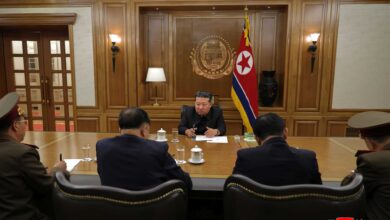Mun Myong Ja, a Korean journalist resident in the US, is widely known in the Western world as being most familiar with the DPRK.
With a three-decade stint as a member of the White House press corps, she has met many renowned figures of the world. A famous women’s magazine of Japan included the celebrity in the list of Top Twelve Women Who Can Shape the World.
In the spring of 1995 when the focus of world attention was on the possible presidential election in the DPRK after Kim Il Sung’s death, the journalist published an article Inheritance of Presidency on the Upcoming October 10.
She confessed later: Would it be possible to leave the presidency of a country vacant for more than one year? I predicted on the basis of my intuitive judgment that there would be inheritance of power within the year. My article turned out to be utterly incorrect. The interregnum lasted three years, leading up to the abolition of presidency. Kim Il Sung was declared the only President of the DPRK.
She was astonished by the subsequent news that the Kumsusan Assembly Hall was renamed the Kumsusan Memorial Palace and the DPRK’s artificial satellite achieved orbit.
She set out on a journey to the DPRK with a strong urge to see Kim Jong Il.
On July 13, 1997, while on his field guidance trip in Hamhung, Kim Jong Il learned that the renowned journalist visited the country to attend the memorial service to be held on the third anniversary of Kim Il Sung’s death. In reply to her repeated requests for an interview, he sent a letter to her.
He wrote in the letter:
“I want to find time and have talks with you during your current visit. I am very sorry that because of several affairs awaiting my attention, I have no time to spare.”
I still remember the President saying in an interview with you that it is a pride of our nation to have such a renowned journalist as you, who is engaging in patriotic activities outside the country with a pen of justice, he stressed. He continued that he had heard a lot about her positive activities for the interests of the country and people and for Korea’s reunification even after the President’s death. He expressed his hope that he would see her during her next visit.
Three years later, when she was visiting the country again, Kim Jong Il met her.
Seeing the woman in traditional Korean clothes, he said that she looked much younger.
He continued, “I have felt ‘indebted’ to you as I promised that I would meet you. So I have found time to pay the ‘debt.’”
That day he had long talks with her giving answers to her questions, and arranged a luncheon in her honour.
Later the journalist wrote in an article:
“Chairman Kim Jong Il was strong yet unassuming. He was one and the same as President Kim Il Sung whom I had met in 1992 and 1993.”

